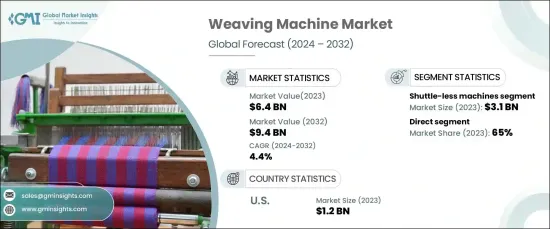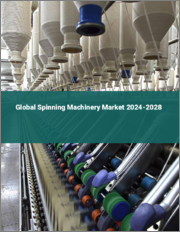
|
시장보고서
상품코드
1665180
세계의 방직기 시장 : 기회, 성장 촉진요인, 산업 동향 분석, 예측(2024-2032년)Weaving Machine Market Opportunity, Growth Drivers, Industry Trend Analysis, and Forecast 2024 - 2032 |
||||||
세계의 방직기 시장은 2023년 64억 달러로 평가되었으며, 2024년부터 2032년까지 연평균 복합 성장률(CAGR) 4.4%로 확대될 것으로 예측됩니다.
이 시장 확대의 주요 요인은 스포츠웨어, 자동차, 패션 등의 산업에서 수요가 높아지고 있는 고기능 섬유 제품에 대한 수요 증가입니다. 이 분야에서는 뛰어난 강도, 유연성 및 혁신적인 디자인을 제공하는 직물이 중시되고 있기 때문에 방직기 시장은 강력한 성장을 이루고 있습니다. 또한 특수 직물에 대한 수요에 대응하기 위해 섬유 생산이 지속적으로 진화하고 있기 때문에 고급 직물 기술의 채택은 오늘날의 어지러운 시장에서 경쟁 우위를 유지하는 데 필수적입니다. 자동화와 디지털화는 매우 중요한 역할을 하고 있으며 제조 공정을 간소화하고 전반적인 효율성을 향상시킵니다. 이러한 혁신의 동향은 방직기기술에 대한 투자 증가에 박차를 가하여 제조업체가 현대 산업의 다양한 요구에 부응할 수 있게 합니다.

셔틀리스 머신 분야는 2023년 31억 달러였고, 예측 기간 중 CAGR은 4.2%의 성장이 예상됩니다. 이러한 고급 방직기는 위사 삽입을 위한 에어, 레이피어, 워터젯 기술을 포함하며 기존 셔틀을 사용하는 모델에 비해 몇 가지 장점이 있습니다. 보다 빠르고 복잡한 패턴을 만들고, 직물 품질을 향상시키고, 작동 소음을 줄일 수 있기 때문에 셔틀리스 방직기는 유연성과 효율성을 요구하는 제조업체로 선택되고 있습니다. 산업계가 보다 빠른 생산 속도와 보다 복잡한 디자인을 요구하는 가운데, 뛰어난 성능을 확보하면서 이러한 요구에 부응할 수 있는 이 기계는 지지를 모으고 있습니다.
| 시장 범위 | |
|---|---|
| 시작 연도 | 2023년 |
| 예측 연도 | 2024-2032년 |
| 시작 금액 | 64억 달러 |
| 예측 금액 | 94억 달러 |
| CAGR | 4.4% |
유통 분야에서는 직접 판매가 2023년 시장 점유율의 65%를 차지했습니다. 이 분야는 제조업체가 고객과 직접적인 관계를 구축하는 경향이 강해지고 있는 것을 배경으로 2032년까지 CAGR 4.5%를 나타낼 것으로 예측됩니다. 이 전환은 제품 납품을 더 잘 관리하고, 고객 서비스를 강화하며, 판매 후 지원을 향상시킬 수 있습니다. 또한 제조업체는 특정 고객 요구 사항에 맞는 솔루션을 제공할 수 있어 시장에서의 경쟁력을 강화할 수 있습니다. 이러한 직접 판매로의 움직임은 경쟁이 치열한 방직기 시장에서 개인화와 서비스의 중요성이 커지고 있음을 반영합니다.
미국의 방직기 시장은 2023년에 12억 달러를 창출했고, 2032년까지 연평균 복합 성장률(CAGR) 4.4%로 안정된 성장이 전망됩니다. 자동차와 패션 등 다양한 분야에서 고성능 직물에 대한 왕성한 수요가 있으며, 최첨단 직물 기술의 채용이 계속되고 있습니다. 미국은 여전히 섬유 산업의 중심지이며, 주요 기계 제조업체는 섬유 생산의 혁신, 자동화 및 디지털화에 중점을 둡니다. 이러한 요인은 기술적 진보를 촉진할 뿐만 아니라 세계 방직기 시장에서 주요 기업로서의 지위를 확립하고 있습니다.
목차
제1장 조사 방법과 조사 범위
- 시장 범위와 정의
- 기본 추정과 계산
- 예측 파라미터
- 데이터 소스
- 1차 데이터
- 2차 데이터
- 유료 정보원
- 공적 정보원
제2장 주요 요약
제3장 업계 인사이트
- 생태계 분석
- 밸류체인에 영향을 주는 요인
- 이익률 분석
- 파괴
- 미래의 전망
- 제조업체
- 유통업체
- 공급자의 상황
- 이익률 분석
- 주요 뉴스와 대처
- 규제 상황
- 기술적 전망
- 영향요인
- 성장 촉진요인
- 자동화 기술의 진보
- 주문 제작 원단에 대한 수요 증가
- 생산 효율과 속도 향상
- 최종 이용 산업 확대(자동차, 패션 등)
- 업계의 잠재적 위험 및 과제
- 높은 초기 투자 비용
- 변동하는 원료 가격
- 성장 촉진요인
- 무역분석(HS코드-8446)
- 수출 상위 10개국
- 수입 상위 10개국
- 성장 가능성 분석
- Porter's Five Forces 분석
- PESTEL 분석
제4장 경쟁 구도
- 소개
- 기업 점유율 분석
- 경쟁 포지셔닝 매트릭스
- 전략 전망 매트릭스
제5장 시장 추계·예측 : 유형별, 2021-2032년
- 주요 동향
- 셔틀 머신
- 셔틀리스 머신
- 전용기
- 기타
제6장 시장 추계·예측 : 조작 유형별, 2021-2032년
- 주요 동향
- 수동
- 반자동
- 전자동
제7장 시장 추계·예측 : 용도별, 2021-2032년
- 주요 동향
- 업홀스터리 페브릭
- 자동차용 텍스타일
- 스포츠웨어
- 기타
제8장 시장 추계·예측 : 유통 채널별, 2021-2032년
- 주요 동향
- 직접 유통
- 간접 유통
제9장 시장 추계·예측 : 지역별, 2021-2032년
- 주요 동향
- 북미
- 미국
- 캐나다
- 유럽
- 영국
- 독일
- 프랑스
- 이탈리아
- 스페인
- 아시아태평양
- 중국
- 일본
- 인도
- 호주
- 한국
- 인도네시아
- 말레이시아
- 라틴아메리카
- 브라질
- 멕시코
- 중동 및 아프리카
- 남아프리카
- 사우디아라비아
- 아랍에미리트(UAE)
제10장 기업 프로파일
- Dornier
- Fong's National Engineering
- Itema
- KARL MAYER
- Laxmi Group
- Lohia Corp Limited
- Nisshinbo Industries
- Picanol
- RIFA
- Saurer Group
- Staubli
- Toyota Industries Corporation
- Vamatex
- Weaving Machinery Solutions
- Zhejiang Hengtai
The Global Weaving Machine Market, valued at USD 6.4 billion in 2023, is projected to expand at a CAGR of 4.4% between 2024 and 2032. This expansion is primarily driven by the rising demand for high-performance textiles, which are increasingly in demand across industries such as sportswear, automotive, and fashion. As these sectors place greater emphasis on fabrics that provide superior strength, flexibility, and innovative designs, the weaving machine market is seeing robust growth. Moreover, with textile production continually evolving to meet the demands for specialized fabrics, the adoption of advanced weaving technologies is crucial to maintaining a competitive advantage in today's fast-paced market. Automation and digitization are playing pivotal roles, streamlining manufacturing processes and improving overall efficiency. This trend towards innovation has sparked increased investment in weaving machine technologies, allowing manufacturers to meet the diverse needs of modern industries.

The shuttle-less machines segment, valued at USD 3.1 billion in 2023, is expected to grow at a CAGR of 4.2% during the forecast period. These advanced weaving machines, which include air, rapier, and water jet technologies for weft insertion, offer several advantages over traditional shuttle-based models. The ability to create intricate patterns at higher speeds, improve fabric quality, and reduce operational noise has made shuttle-less machines the go-to choice for manufacturers looking for flexibility and efficiency. As industries demand faster production speeds and more complex designs, these machines continue to gain favor for their ability to meet these needs while ensuring superior performance.
| Market Scope | |
|---|---|
| Start Year | 2023 |
| Forecast Year | 2024-2032 |
| Start Value | $6.4 Billion |
| Forecast Value | $9.4 Billion |
| CAGR | 4.4% |
In the distribution sector, direct sales accounted for a significant 65% market share in 2023. This segment is expected to experience a CAGR of 4.5% through 2032, driven by the increasing trend of manufacturers establishing direct relationships with customers. This shift allows for better control over product delivery, enhances customer service, and provides improved after-sales support. Furthermore, manufacturers can offer more tailored solutions to meet specific customer requirements, strengthening their competitive edge in the market. This move toward direct sales also reflects the growing importance of personalization and service in the highly competitive weaving machine market.
In the U.S., the weaving machine market generated USD 1.2 billion in 2023, with expectations of steady growth at a CAGR of 4.4% by 2032. The strong demand for high-performance textiles across various sectors, including automotive and fashion, continues to propel the adoption of cutting-edge weaving technologies. The U.S. remains a central hub for the industry, with leading machinery manufacturers emphasizing innovation, automation, and digitalization in textile production. These factors not only foster technological advancements but also position the country as a key player in the global weaving machine market.
Table of Contents
Chapter 1 Methodology & Scope
- 1.1 Market scope & definition
- 1.2 Base estimates & calculations
- 1.3 Forecast parameters
- 1.4 Data sources
- 1.4.1 Primary
- 1.5 Secondary
- 1.5.1.1 Paid sources
- 1.5.1.2 Public sources
Chapter 2 Executive Summary
- 2.1 Industry synopsis, 2021 - 2032
Chapter 3 Industry Insights
- 3.1 Industry ecosystem analysis
- 3.1.1 Factor affecting the value chain
- 3.1.2 Profit margin analysis
- 3.1.3 Disruptions
- 3.1.4 Future outlook
- 3.1.5 Manufacturers
- 3.1.6 Distributors
- 3.2 Supplier landscape
- 3.3 Profit margin analysis
- 3.4 Key news & initiatives
- 3.5 Regulatory landscape
- 3.6 Technological landscape
- 3.7 Impact forces
- 3.7.1 Growth drivers
- 3.7.1.1 Technological advancements in automation
- 3.7.1.2 Rising demand for customized fabrics
- 3.7.1.3 Increased production efficiency and speed
- 3.7.1.4 Expansion of end-use industries (automotive, fashion, etc.)
- 3.7.2 Industry pitfalls & challenges
- 3.7.2.1 High initial investment costs
- 3.7.2.2 Fluctuating raw material prices
- 3.7.1 Growth drivers
- 3.8 Trade analysis (HS Code- 8446)
- 3.8.1 Top 10 export countries
- 3.8.2 Top 10 import countries
- 3.9 Growth potential analysis
- 3.10 Porter’s analysis
- 3.11 PESTEL analysis
Chapter 4 Competitive Landscape, 2023
- 4.1 Introduction
- 4.2 Company market share analysis
- 4.3 Competitive positioning matrix
- 4.4 Strategic outlook matrix
Chapter 5 Market Estimates and Forecast, By Type, 2021 – 2032 (USD Billion) (Thousand Units)
- 5.1 Key trends
- 5.2 Shuttle machines
- 5.3 Shuttle-less machines
- 5.4 Specialized machines
- 5.5 Others
Chapter 6 Market Estimates and Forecast, By Operation Type, 2021 – 2032 (USD Billion) (Thousand Units)
- 6.1 Key trends
- 6.2 Manual
- 6.3 Semi-Automatic
- 6.4 Fully automatic
Chapter 7 Market Estimates and Forecast, By Usage, 2021 – 2032 (USD Billion) (Thousand Units)
- 7.1 Key trends
- 7.2 Upholstery fabric
- 7.3 Automotive textiles
- 7.4 Sportswear
- 7.5 Others
Chapter 8 Market Estimates & Forecast, By Distribution Channel, 2021 – 2032, (USD Billion) (Thousand Units)
- 8.1 Key trends
- 8.2 Direct
- 8.3 Indirect
Chapter 9 Market Estimates & Forecast, By Region, 2021 – 2032, (USD Billion) (Thousand Units)
- 9.1 Key trends
- 9.2 North America
- 9.2.1 U.S.
- 9.2.2 Canada
- 9.3 Europe
- 9.3.1 UK
- 9.3.2 Germany
- 9.3.3 France
- 9.3.4 Italy
- 9.3.5 Spain
- 9.4 Asia Pacific
- 9.4.1 China
- 9.4.2 Japan
- 9.4.3 India
- 9.4.4 Australia
- 9.4.5 South Korea
- 9.4.6 Indonesia
- 9.4.7 Malaysia
- 9.5 Latin America
- 9.5.1 Brazil
- 9.5.2 Mexico
- 9.6 MEA
- 9.6.1 South Africa
- 9.6.2 Saudi Arabia
- 9.6.3 UAE
Chapter 10 Company Profiles (Business Overview, Financial Data, Product Landscape, Strategic Outlook, SWOT Analysis)
- 10.1 Dornier
- 10.2 Fong’s National Engineering
- 10.3 Itema
- 10.4 KARL MAYER
- 10.5 Laxmi Group
- 10.6 Lohia Corp Limited
- 10.7 Nisshinbo Industries
- 10.8 Picanol
- 10.9 RIFA
- 10.10 Saurer Group
- 10.11 Staubli
- 10.12 Toyota Industries Corporation
- 10.13 Vamatex
- 10.14 Weaving Machinery Solutions
- 10.15 Zhejiang Hengtai














